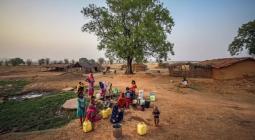Half of Americans have faced ‘extreme’ weather in the last six weeks

Half of the US population has faced an extreme weather alert since 1 May and many more are likely to face risks from wildfires, flooding, tropical storms and extreme heat as summer begins.
The Union of Concerned Scientists (UCS) has been tracking the alerts sent by the National Weather Service (NWS) warning about dangerous weather.
The UCS also finds that more than 51 million people in the US were facing extreme weather alerts on Wednesday, with about a third of them living in areas designated as disadvantaged by the federal government.
The period between May and November is a period the UCS is calling “Danger Season”, when increasingly intense storms, heatwaves and wildfires are expected to besiege the country. Fifty per cent “is a very troubling sort of threshold that we’ve crossed”, said Juan Declet-Barreto, a senior social scientist for climate vulnerability at UCS. “And we are one month and a half into danger season.”
In recent days, storms battering the Lower Mississippi Valley and central Gulf coast states have downed power lines and mangled homes. In Texas, triple-digit temperatures are straining the power grid. The heat index has surpassed 120F in parts of the state, due to an unusually intense high pressure system.
About 10% of the extreme heat alerts this year have a clear “climate signal” linking them to the climate crisis, said Declet-Barreto. That figure is based on the non-profit Climate Central’s Climate Shift Index, which estimates the influence of climate change on extreme temperatures around the world. In Texas, the heat was made at least three, four and five times as likely by climate change, the Index indicates.
Overall, numerous studies have found that the climate crisis is fueling more intense and prolonged heatwaves, storms, droughts and floods.
Meanwhile, the Electric Reliability Council of Texas (Ercot), the grid operator, has asked Texans to voluntarily reduce electricity use to address soaring demand. “This is just another signal of how climate change is affecting our infrastructure,” said Rachel Cleetus, the policy director and lead economist in the Climate and Energy Program at UCS. Ercot issued similar warnings last summer and in 2021, hundreds died after the state grid was pushed to the brink of total failure, amid an extreme winter storm.
Meanwhile, the Electric Reliability Council of Texas (Ercot), the grid operator, has asked Texans to voluntarily reduce electricity use to address soaring demand. “This is just another signal of how climate change is affecting our infrastructure,” said Rachel Cleetus, the policy director and lead economist in the Climate and Energy Program at UCS. Ercot issued similar warnings last summer and in 2021, hundreds died after the state grid was pushed to the brink of total failure, amid an extreme winter storm.
cover photo:A man cools off near a fountain during a heatwave in Houston, Texas, when temperatures reached 98F (37C). Photograph: Bloomberg/Getty Images








